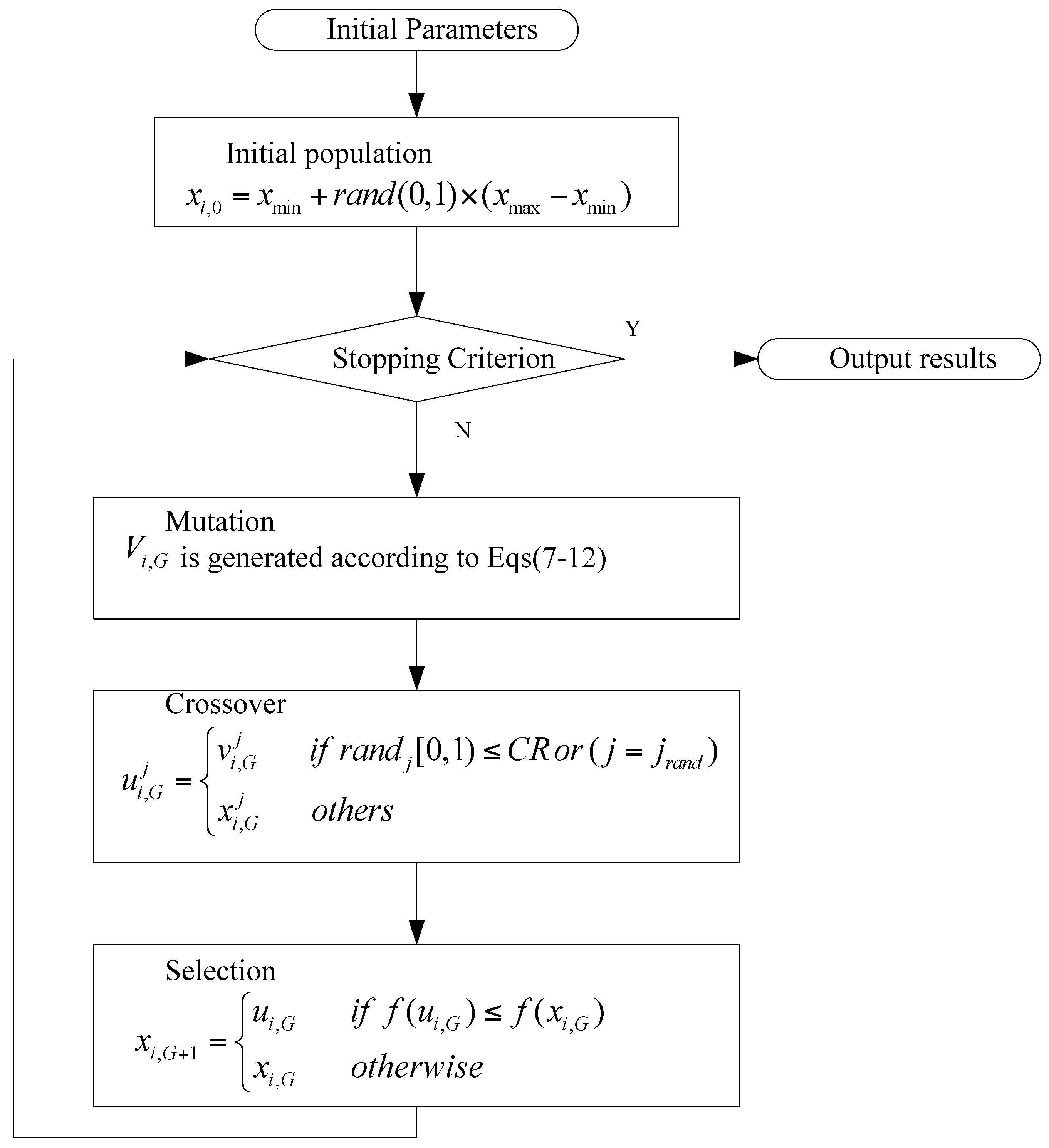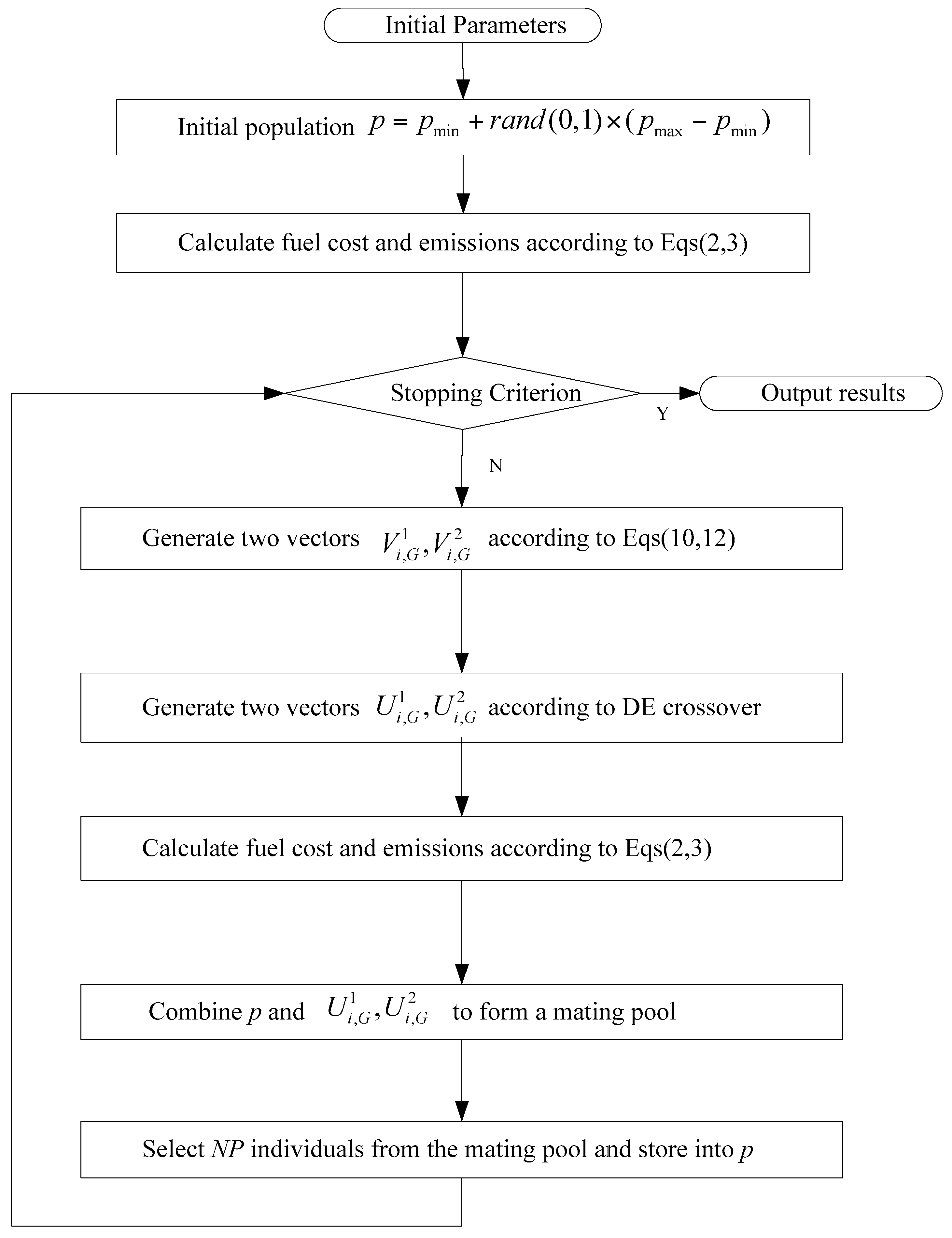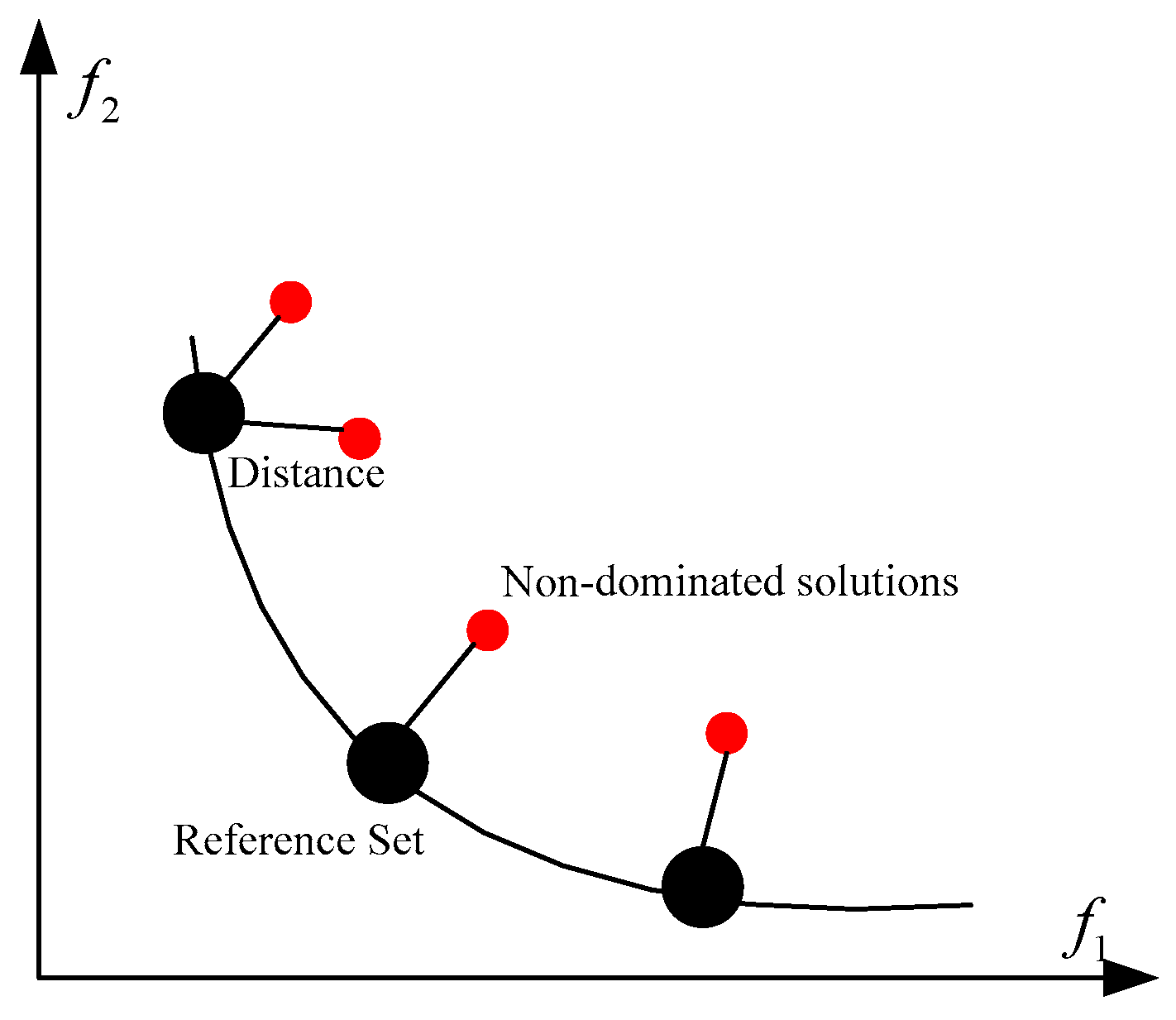1. Introduction
Currently, every country has enacted strict regulations and laws to protect the environment from pollution [
1]. For example, the US Clean Air act was implemented in 1990. This act mandates that power companies should reduce NO
X by 2 million ton/year and SO
2 emission by 10 million ton/year from 1980 levels [
2,
3]. In the past decades, China’s government has also enacted related laws and regulations to protect the environment [
1,
3,
4,
5,
6,
7]. However, when power companies generate electricity, they produce harmful pollutants. Thus, these companies have to reduce the emissions of these harmful pollutants, such as CO
2, CO and NOx [
8]. Therefore, the economic and emission dispatch (EED) problem is a highly critical problem for power companies. The problem consists of two objectives, including minimization costs and emissions with the constraints. It is a typical non-linear constrained multi-objective optimization problem (CMOP).
This problem has to deal with linear/nonlinear, equality/inequality constraints, concave feasible region, et al. Consequently, many traditional optimization approaches may not be attractive since they are computationally expensive or easily get stuck at local optima. In the past decade, evolutionary algorithms have been obtained increasingly attention for solving the problem due to their adaptability and flexibility to the task [
9]. Currently, there are many approaches proposed to handle the economic and emission dispatch (EED) problem. These approaches can be classified into two categories.
The first one is to transform the problem into a single optimization problem [
10]. Generally, different objectives are combined by the relative weights among these objectives. This category generally applies the following method to form a new objective function:
where
w is the relative weight between fuel costs
(
$/h) and emissions
(ton/h),
is a scaling factor and
Ng is the number of generators [
8,
11,
12,
13,
14,
15,
16,
17,
18,
19,
20,
21]. The EED problem is converted into single objective function using the penalty factor. The main advantage of the method is that it is easy to implement. However, it is highly difficult to identify suitable weights among different objectives. Multiple runs are often required for the sake of obtaining non-dominated solutions. In the past decades, multi-objective evolutionary algorithms (MOEAs) have made considerable progress. These algorithms are widely applied to solve the EED problem.
The second category addresses the EED problem of MOEAs. These population-based optimization algorithms can obtain multiple non-dominated solutions in a single run. This approach can overcome the main disadvantage of the first category. As the performances of MOEAs are attractive, they have been widely employed to solve the EED problem. A multi-strategy ensemble biogeography-based optimization algorithm is proposed to solve the EED problem [
22]. A new MOEA based on an enhanced firefly algorithm is proposed to acquire a set of non-dominated solutions and to solve various EED problems [
23]. The differential evolution (DE) algorithm and PSO (particle swarm optimization) algorithm are combined to form a new hybrid algorithm called DEPSO. The proposed hybrid algorithm is used to address the EED problem [
24]. A trust region algorithm based on the MOEA is presented to cope with the problem [
25]. A time varying acceleration PSO is proposed to improve the solutions of the EED problem [
26]. A quantum-behaved PSO algorithm is introduced to address the EED problem [
27]. A new bare-bones multi-objective PSO algorithm is designed to solve the EED problem [
28]. An extended NSGA-II algorithm is presented for the EED problem [
2]. A new two-archive multi-objective grey wolf algorithm is presented to solve reactive power dispatch problems [
29].
From the above discussion, it is noticed that MOEAs are widely used in the field of EEDs. In the recent years, the DE as one EA has attracted increasing attention due to its attractive performance. It is a simple powerful optimization algorithm created by Storn and Price [
30]. Many multi-objective differential evolution (MODE) algorithms have been proposed and achieved remarkable performances compared to other MOEAs when solving the EED problem. A modified version of MODE is used to tackle the extended dynamic EED problem. In MODE, an ensemble of selection method is implemented [
31]. A new extended adaptive MODE algorithm is adopted by double selection and adaptive random restart operators to solve the EED problem. The efforts can avoid premature. Moreover, a new constraint handling technique is also implemented [
32]. A DE algorithm based on the orthogonal design method and e-domination is implemented to solve the EED problem for the purpose of saving energy and protecting environment [
33]. A summation based on the multi-objective differential evolution (SMODE) algorithm is used to optimize the EED problem with stochastic wind power [
34]. An extended multi-objective binary DE algorithm is presented to solve the EED problem. A marginal correction is used to handle various constraints [
35]. An enhanced multi-objective DE algorithm is presented to solve the EED problem to realize the aim of the minimization of fuel costs and emission effects. The operators of DE are modified and an elitist archive technique is used to retain the non-dominated solutions during the evolution [
36]. The MODE algorithm is proposed to solve the EED problem, which uses an external elitist archive to retain non-dominated solutions during the evolution [
37]. The modified differential evolution (MDE) uses five differential solutions instead of three like the conventional DE to solve the EED problem [
38]. An improved multi-objective differential evolution algorithm contains the chaos initialization strategy, the parameter adaptive strategy and the dynamic non-dominated sorting strategy to address the EED problem [
39]. A DE combined with Gaussian mutation (DEGM) is implemented to handle the EED problem [
40].
In fact, the EED problem is a typical constraint multi-objective problem (MOP). Multi-objectives have to be solved and constraints have to be satisfied. Balancing objective optimization and constraint satisfaction are two equally important goals. In the above proposed algorithms based on the DE, there is only one mutation strategy used. In fact, the mutation strategy plays an important role during evolution. In the light of the no free lunch theorem, no single mutation strategy can outperform all others on every optimization problem [
41]. In most DE variants, only mutation strategy is adopted to generate trial vector. Thus, the search ability is limited. In fact, different mutation strategies have different features. Chosen mutation strategies have distinct advantages and they can be effectively cooperated and combined to optimize different kinds of problems. The idea is widely used in single optimize problem [
42]. Composite DE (CoDE) uses rand/1/bin, rand/2/bin and current-to-rand/1 to generate trial vectors. Simulation results have shown that CoDE is very competitive on all the CEC2005 test functions [
42].Three mutation strategies DE/rand/1, DE/best/2 and DE/current-to-rand/1 are chosen to form a mutation strategy pool. Compared with conventional DE and adaptive DE algorithms, simulation results have proven that the ensemble method has achieved better performance [
43]. As classical evolutionary programming (CEP) with Gaussian mutation is better at searching in a local neighborhood while the fast EP (FEP) with the Cauchy mutation performs better over a larger neighborhood, an ensemble approach is proposed by combining adaptive EP, Gaussian and Cauchy mutations, the experimental results have revealed that the ensemble is better than the single mutation-based algorithms [
44]. Different mutation and update strategies are implemented in mDE-bES [
45]. An ensemble of multiple strategies is realized by a multi-population based approach. Extensive experiments show that the proposed method is competitive [
46]. An ensemble DE algorithm is proposed to classify electromagnetic targets in resonance scattering region. Compared with DE variants, the performance of the proposed algorithm is better [
47]. Thus, all the above simulation results and evidences have clearly revealed that different strategies can be more appropriate and benefit can be derived from the availability of diverse strategies.
Based on the observation, the ensemble mutation strategies of the DE are implemented. As the multi-objective optimization problems are different from single optimization problems, Pareto theory is used to select best solutions. Thus, mutation strategies chosen are different from the single optimization problems. In addition, in order to cope with the equality constraints in the EED problem, a new mechanism is proposed by transforming the equality constraint into the inequality constraint. Next, the constraint domination principle is adopted to select these solutions to enter the next generation. By these efforts, a novel ensemble MODE (EMODE) is implemented to solve the EED problem. The primary advantage is that the proposed algorithm uses two different mutation operators. They have different features and can cooperate with each other to accelerate the optimization process while retaining the diversity of the population. To validate the performance of the proposed algorithm EMODE, it has been compared with the latest single optimization algorithms and MOEAs. Based on the benchmark test functions (CTP2~CTP7), the proposed algorithm is better than NSGAII [
48] and MODE with mutation strategy DE/rand/1 according to the performance indicator Inverted Generational Distance (IGD). Then, the algorithm is used to solve the EED problem. Compared with the latest single optimization, the proposed algorithm is better than the recursive, PSO, DE and improved recursive. Compared with MOEAs, EMODE is better than MODE and SPEA 2. The NSGAII, PDE and EMODE have achieved similar performance. We can get the conclusion that the proposed algorithm is competitive.
The paper is organized as follows. In
Section 2, the EED problem is briefly introduced. The conventional DE is presented and the proposed algorithm is developed in
Section 3. In
Section 4, experiments on the EED problem are performed. The study’s conclusions are presented in
Section 5.
2. Economic Emission Dispatch (EED) Problem
The major aim of power companies is to schedule the generators’ output to satisfy the load requirements with minimum fuel costs without considering emissions. Currently, every country has begun to protect the environment from pollution. These power companies have to make alternative strategies to reduce pollutants such that they can meet the requirements of environmental protection. Otherwise, they will be severely punished. The EED problem is a typical MOP [
10]. Addressing this problem requires simultaneously minimizing fuel costs and emission levels. Meanwhile, this approach has to meet certain constraints. First, some notations have to be presented such that the problem can be clearly explained. The notations are as follows [
10]:
: The output power of the generator
: The fuel cost coefficients of the generator
: The emission coefficients of the generator
: The number of generators
: The total load demand
: The power losses
: The minimum power output of the generator
: The maximum power output of the generator
: The loss coefficient between the generator and the generator
: The total fuel costs function
: The total emissions function
: The total cost of generators
The total fuel costs function
can be presented by the following equation
The emission may be SO
2 or NOx. They are released by fossil fuels in power plants. The total emission function
can be defined as
Thus, the multi-objective of the EED problem can be given as follows:
When optimizing the EED problem, some constraints have to be met. The first one is power balance. The total power generated has to equal to the total power required and total power lost. It can be expressed as
The second constraint is the capacity constraint. The output power of every generator unit is constrained by the range limits:









